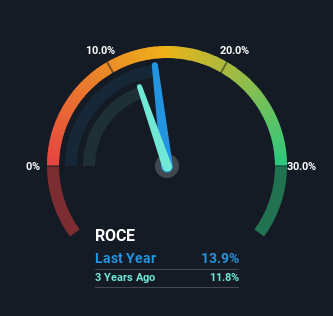The Returns At Pujiang International Group (HKG:2060) Aren't Growing

What trends should we look for it we want to identify stocks that can multiply in value over the long term? In a perfect world, we'd like to see a company investing more capital into its business and ideally the returns earned from that capital are also increasing. If you see this, it typically means it's a company with a great business model and plenty of profitable reinvestment opportunities. With that in mind, the ROCE of Pujiang International Group (HKG:2060) looks decent, right now, so lets see what the trend of returns can tell us.
Return On Capital Employed (ROCE): What Is It?
If you haven't worked with ROCE before, it measures the 'return' (pre-tax profit) a company generates from capital employed in its business. The formula for this calculation on Pujiang International Group is:
Return on Capital Employed = Earnings Before Interest and Tax (EBIT) ÷ (Total Assets - Current Liabilities)
0.14 = CN¥339m ÷ (CN¥5.8b - CN¥3.3b) (Based on the trailing twelve months to June 2023).
Thus, Pujiang International Group has an ROCE of 14%. On its own, that's a standard return, however it's much better than the 7.4% generated by the Machinery industry.
View our latest analysis for Pujiang International Group

Historical performance is a great place to start when researching a stock so above you can see the gauge for Pujiang International Group's ROCE against it's prior returns. If you're interested in investigating Pujiang International Group's past further, check out this free graph of past earnings, revenue and cash flow.
What The Trend Of ROCE Can Tell Us
While the returns on capital are good, they haven't moved much. The company has employed 104% more capital in the last five years, and the returns on that capital have remained stable at 14%. Since 14% is a moderate ROCE though, it's good to see a business can continue to reinvest at these decent rates of return. Stable returns in this ballpark can be unexciting, but if they can be maintained over the long run, they often provide nice rewards to shareholders.
Another point to note, we noticed the company has increased current liabilities over the last five years. This is intriguing because if current liabilities hadn't increased to 58% of total assets, this reported ROCE would probably be less than14% because total capital employed would be higher.The 14% ROCE could be even lower if current liabilities weren't 58% of total assets, because the the formula would show a larger base of total capital employed. So with current liabilities at such high levels, this effectively means the likes of suppliers or short-term creditors are funding a meaningful part of the business, which in some instances can bring some risks.
Our Take On Pujiang International Group's ROCE
In the end, Pujiang International Group has proven its ability to adequately reinvest capital at good rates of return. What's surprising though is that the stock has collapsed 91% over the last three years, so there might be other areas of the business hurting its prospects. In any case, we like the underlying trends and would look further into this stock.
One more thing: We've identified 3 warning signs with Pujiang International Group (at least 1 which is significant) , and understanding them would certainly be useful.
While Pujiang International Group may not currently earn the highest returns, we've compiled a list of companies that currently earn more than 25% return on equity. Check out this free list here.
New: Manage All Your Stock Portfolios in One Place
We've created the ultimate portfolio companion for stock investors, and it's free.
• Connect an unlimited number of Portfolios and see your total in one currency
• Be alerted to new Warning Signs or Risks via email or mobile
• Track the Fair Value of your stocks
Have feedback on this article? Concerned about the content? Get in touch with us directly. Alternatively, email editorial-team (at) simplywallst.com.
This article by Simply Wall St is general in nature. We provide commentary based on historical data and analyst forecasts only using an unbiased methodology and our articles are not intended to be financial advice. It does not constitute a recommendation to buy or sell any stock, and does not take account of your objectives, or your financial situation. We aim to bring you long-term focused analysis driven by fundamental data. Note that our analysis may not factor in the latest price-sensitive company announcements or qualitative material. Simply Wall St has no position in any stocks mentioned.
About SEHK:2060
Pujiang International Group
An investment holding company, manufactures, sells, and installs bridge cables and prestressed materials in the People’s Republic of China.
Slightly overvalued with imperfect balance sheet.
Market Insights
Community Narratives




